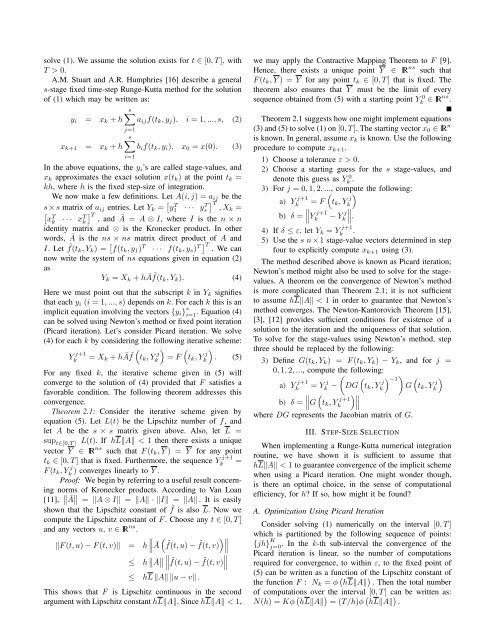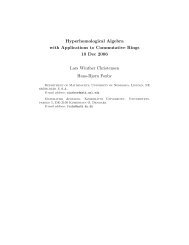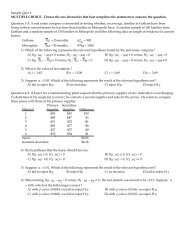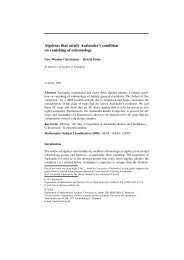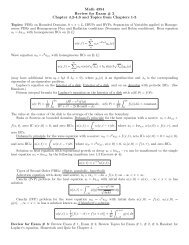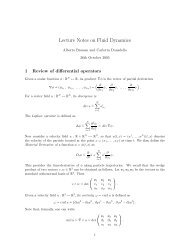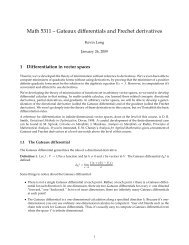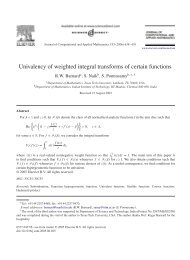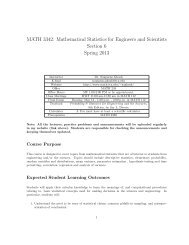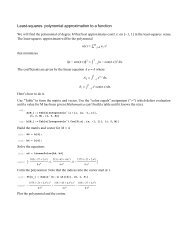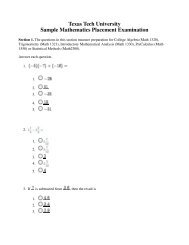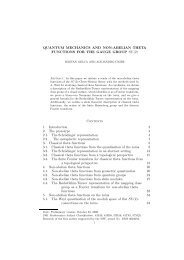A Variable Step-Size Selection Method for Implicit Integration ...
A Variable Step-Size Selection Method for Implicit Integration ...
A Variable Step-Size Selection Method for Implicit Integration ...
You also want an ePaper? Increase the reach of your titles
YUMPU automatically turns print PDFs into web optimized ePapers that Google loves.
solve (1). We assume the solution exists <strong>for</strong> t ∈ [0, T ], with<br />
T > 0.<br />
A.M. Stuart and A.R. Humphries [16] describe a general<br />
s-stage fixed time-step Runge-Kutta method <strong>for</strong> the solution<br />
of (1) which may be written as:<br />
s∑<br />
y i = x k + h a ij f(t k , y j ), i = 1, ..., s, (2)<br />
x k+1 = x k + h<br />
j=1<br />
s∑<br />
b i f(t k , y i ), x 0 = x(0). (3)<br />
i=1<br />
In the above equations, the y i ’s are called stage-values, and<br />
x k approximates the exact solution x(t k ) at the point t k =<br />
kh, where h is the fixed step-size of integration.<br />
We now make a few definitions. Let A(i, j) = a ij be the<br />
s × s matrix of a ij entries. Let Y k = [ ]<br />
y1<br />
T · · · ys<br />
T T<br />
, Xk =<br />
[ ]<br />
x<br />
T<br />
k<br />
· · · x T T<br />
k , and Ā = A ⊗ I, where I is the n × n<br />
identity matrix and ⊗ is the Kronecker product. In other<br />
words, Ā is the ns × ns matrix direct product of A and<br />
I. Let ˜f(tk , Y k ) = [ f(t k , y 1 ) T · · · f(t k , y s ) ] T T<br />
. We can<br />
now write the system of ns equations given in equation (2)<br />
as<br />
Y k = X k + hĀ ˜f(t k , Y k ). (4)<br />
Here we must point out that the subscript k in Y k signifies<br />
that each y i (i = 1, ..., s) depends on k. For each k this is an<br />
implicit equation involving the vectors {y i } s i=1<br />
. Equation (4)<br />
can be solved using Newton’s method or fixed point iteration<br />
(Picard iteration). Let’s consider Picard iteration. We solve<br />
(4) <strong>for</strong> each k by considering the following iterative scheme:<br />
Y j+1<br />
k<br />
= X k + hĀ ˜f<br />
( ) ( )<br />
t k , Y j<br />
k<br />
= F t k , Y j<br />
k<br />
. (5)<br />
For any fixed k, the iterative scheme given in (5) will<br />
converge to the solution of (4) provided that F satisfies a<br />
favorable condition. The following theorem addresses this<br />
convergence.<br />
Theorem 2.1: Consider the iterative scheme given by<br />
equation (5). Let L(t) be the Lipschitz number of f, and<br />
let A be the s × s matrix given above. Also, let L =<br />
sup t∈[0,T ] L(t). If hL‖A‖ < 1 then there exists a unique<br />
vector Y ∈ IR ns such that F (t k , Y ) = Y <strong>for</strong> any point<br />
t k ∈ [0, T ] that is fixed. Furthermore, the sequence Y j+1<br />
k<br />
=<br />
F (t k , Y j<br />
k<br />
) converges linearly to Y .<br />
Proof: We begin by referring to a useful result concerning<br />
norms of Kronecker products. According to Van Loan<br />
[11], ∥ ∥Ā ∥ = ‖A ⊗ I‖ = ‖A‖ · ‖I‖ = ‖A‖ . It is easily<br />
shown that the Lipschitz constant of ˜f is also L. Now we<br />
compute the Lipschitz constant of F . Choose any t ∈ [0, T ]<br />
and any vectors u, v ∈ IR ns .<br />
( )∥<br />
∥<br />
∥∥<br />
‖F (t, u) − F (t, v)‖ = h ∥Ā ˜f(t, u) − ˜f(t, v)<br />
≤<br />
h ∥ ∥Ā ∥ ∥ ∥ ∥ ∥ ˜f(t, u) − ˜f(t, v)<br />
∥ ∥∥<br />
≤ hL ‖A‖ ‖u − v‖ .<br />
This shows that F is Lipschitz continuous in the second<br />
argument with Lipschitz constant hL‖A‖. Since hL‖A‖ < 1,<br />
we may apply the Contractive Mapping Theorem to F [9].<br />
Hence, there exists a unique point Y ∈ IR ns such that<br />
F (t k , Y ) = Y <strong>for</strong> any point t k ∈ [0, T ] that is fixed. The<br />
theorem also ensures that Y must be the limit of every<br />
sequence obtained from (5) with a starting point Yk 0 ∈ IRns .<br />
Theorem 2.1 suggests how one might implement equations<br />
(3) and (5) to solve (1) on [0, T ]. The starting vector x 0 ∈ IR n<br />
is known. In general, assume x k is known. Use the following<br />
procedure to compute x k+1 .<br />
1) Choose a tolerance ε > 0.<br />
2) Choose a starting guess <strong>for</strong> the s stage-values, and<br />
denote this guess as Yk 0.<br />
3) For j = 0, 1, 2, ...,<br />
(<br />
compute<br />
)<br />
the following:<br />
a) Y j+1<br />
k<br />
= F t k , Y j<br />
k<br />
∥<br />
b) δ = ∥Y j+1 − Y j ∥<br />
∥.<br />
k<br />
k<br />
4) If δ ≤ ε, let Y k = Y j+1<br />
k<br />
.<br />
5) Use the s n × 1 stage-value vectors determined in step<br />
four to explicitly compute x k+1 using (3).<br />
The method described above is known as Picard iteration;<br />
Newton’s method might also be used to solve <strong>for</strong> the stagevalues.<br />
A theorem on the convergence of Newton’s method<br />
is more complicated than Theorem 2.1; it is not sufficient<br />
to assume hL‖A‖ < 1 in order to guarantee that Newton’s<br />
method converges. The Newton-Kantorovich Theorem [15],<br />
[3], [12] provides sufficient conditions <strong>for</strong> existence of a<br />
solution to the iteration and the uniqueness of that solution.<br />
To solve <strong>for</strong> the stage-values using Newton’s method, step<br />
three should be replaced by the following:<br />
3) Define G(t k , Y k ) = F (t k , Y k ) − Y k , and <strong>for</strong> j =<br />
0, 1, 2, ..., compute the following:<br />
( ) ) −1 ( )<br />
a) Y j+1<br />
k<br />
= Y j<br />
k<br />
(DG − t k , Y j<br />
k<br />
G t k , Y j<br />
k<br />
( )∥<br />
∥<br />
b) δ = ∥G t k , Y j+1 ∥∥<br />
k<br />
where DG represents the Jacobian matrix of G.<br />
III. STEP-SIZE SELECTION<br />
When implementing a Runge-Kutta numerical integration<br />
routine, we have shown it is sufficient to assume that<br />
hL‖A‖ < 1 to guarantee convergence of the implicit scheme<br />
when using a Picard iteration. One might wonder though,<br />
is there an optimal choice, in the sense of computational<br />
efficiency, <strong>for</strong> h? If so, how might it be found?<br />
A. Optimization Using Picard Iteration<br />
Consider solving (1) numerically on the interval [0, T ]<br />
which is partitioned by the following sequence of points:<br />
{jh} K j=0<br />
. In the k-th sub-interval the convergence of the<br />
Picard iteration is linear, so the number of computations<br />
required <strong>for</strong> convergence, to within ε, to the fixed point of<br />
(5) can be written as a function of the Lipschitz constant of<br />
the function F : N k = φ ( hL‖A‖ ) . Then the total number<br />
of computations over the interval [0, T ] can be written as:<br />
N(h) = Kφ ( hL‖A‖ ) = (T/h)φ ( hL‖A‖ ) .


